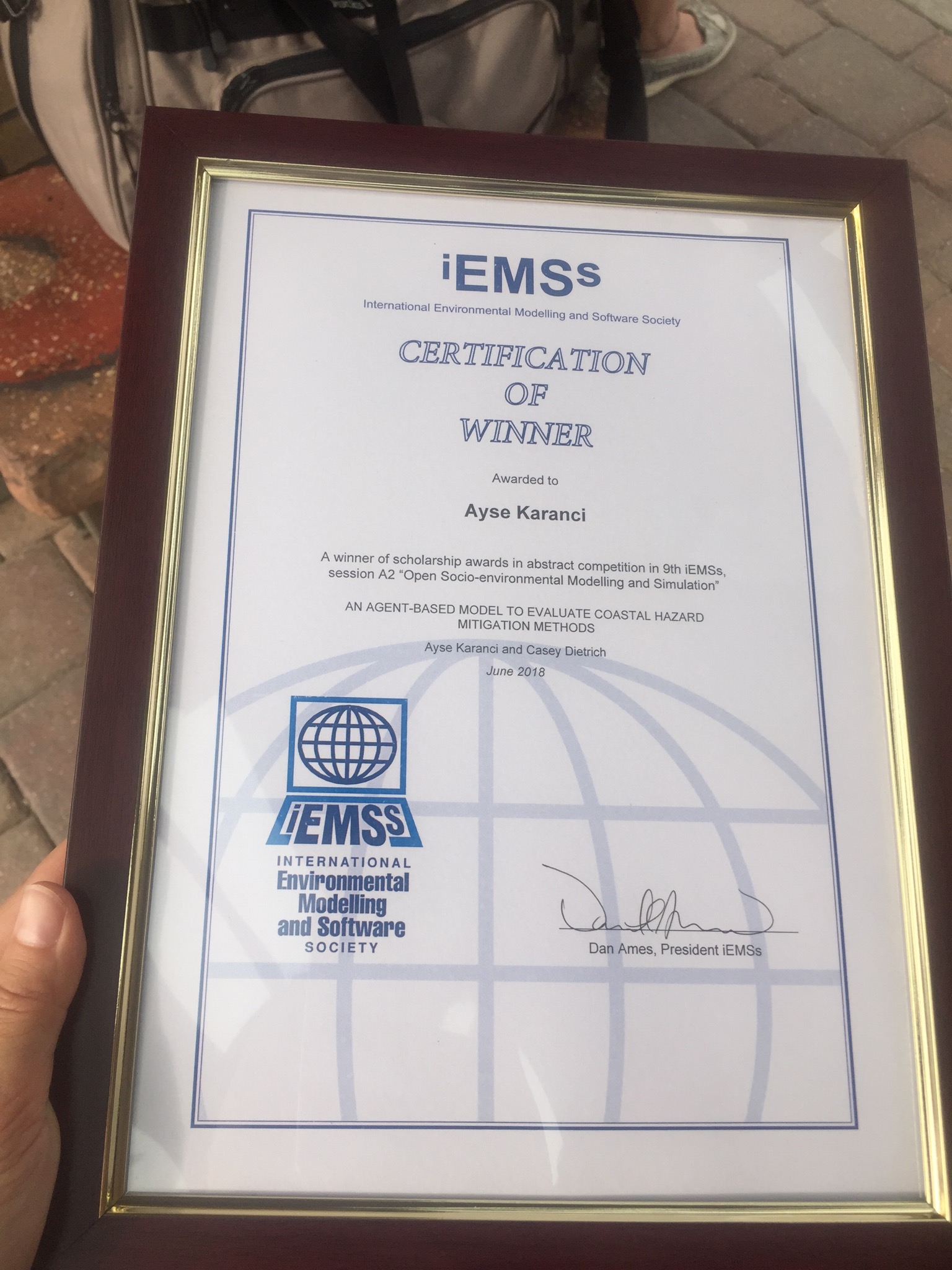
Members of the NCSU coastal engineering team celebrating the successful PhD defense by Rosemary Cyriac.


Members of the NCSU coastal engineering team celebrating the successful PhD defense by Rosemary Cyriac.
Much of the North Carolina coast is lined with sandy beaches and dunes, which can erode during storms, allowing sand onto major roadways and floodwaters into communities. To develop predictions for this erosion and its effects on infrastructure, it was critical to collect observations shortly after the storm. A multi-disciplinary team led by Dr. Elizabeth Sciaudone traveled to Dare County to collect time-sensitive data at Kitty Hawk, Nags Head, Pea Island, and Hatteras Island. Working in conjunction with the Institute for Transportation Research and Education (ITRE), the Center for Geospatial Analytics in the College of Natural Resources, and industry partner SenseFly, researchers surveyed beach and dune changes. Real-Time Kinematic GPS equipment was used to survey select cross-shore beach and dune profiles and document the extent of dune erosion and overwash (inland sand deposits), such as when NC Highway 12 becomes covered after large storms.
Hurricane Florence, which is now a Category 2 storm, continues to bear down on the Carolina coast. The National Weather Service says it is likely to be “the storm of a lifetime” for certain portions of that coastline. Officials have ordered the evacuation of over 1 million people from the coasts of North and South Carolina. … Stasio is joined by Casey Dietrich, a professor in North Carolina State University’s Department of Civil, Construction and Environmental Engineering and leader of its Coastal and Computational Hydraulics Team. Dietrich explains the models currently being refined to help predict and plan for hurricanes and their effects on coastlines.
For this episode of The State of Things, the full-length podcast is embedded below. The interview with Casey Dietrich starts at about the 37-minute mark. It was great to describe our projects with DHS, NSF, and NC Sea Grant as part of this episode about Hurricane Florence.
 Ayse Karanci was a winner in the abstract competition at the 9th International Congress on Environmental Modelling and Software. The award included funding to support her travel to the conference in Fort Collins, Colorado, where she presented on “Cyberinfrastructure for Enhancing Interdisciplinary Engagement in Coastal Risk Management Research.”
Ayse Karanci was a winner in the abstract competition at the 9th International Congress on Environmental Modelling and Software. The award included funding to support her travel to the conference in Fort Collins, Colorado, where she presented on “Cyberinfrastructure for Enhancing Interdisciplinary Engagement in Coastal Risk Management Research.”
Although Ayse was never an official member of the CCHT, she did contribute to our Risk Analytics Discovery Environment (RADE) project. Her presentation was related to that project, in which she developed containers for her models for coastal erosion and decision-making in coastal households. We are very proud of her good work.
Planning for a hurricane is a complicated process involving many stakeholders and varying degrees of uncertainty. Accurate predictions of storm surge and wave heights are vital to decision-making before, during and after the storm. Creating these predictions through modeling software can be expensive and time-consuming. When dealing with hurricanes, time is critical for emergency managers and other officials.
Helping decision-makers to save valuable prediction time is CRC Principal Investigator Dr. Casey Dietrich of North Carolina State University (NCSU). His project, “Improving the Efficiency of Wave and Surge Models via Adaptive Mesh Resolution,” involves collaboration with co-PI Dr. Clint Dawson at the University of Texas at Austin. Their project focuses on speeding up a widely used prediction tool, ADCIRC. His work with North Carolina Emergency Management during Hurricane Matthew in 2016, and his contributions to developing future disaster resilience specialists, have helped make significant contributions to disaster preparation and recovery.
Computer models can make surge predictions based on limited information about storm characteristics such as track, size, maximum wind speed and central pressure. Those parameters are used to predict the surface pressures and wind speeds throughout a coastal region. Those atmospheric conditions are then used to predict how the ocean will respond by generating large waves and surge, and by flooding into low-lying areas.
Given all the variables involved, there’s a lot of room for error in storm wind and surge prediction modeling.
For our study, we wanted to know how forecasting errors affect subsequent coastal flooding predictions. To that end, we needed to answer a couple of questions: First, as a storm moves closer to the coast, how accurate are forecasts of certain storm parameters like track, size, and maximum wind speed? Second, how do those forecasts affect predictions of wind speeds and storm surge?
Teaching students from a wide range of experiences and interests, Dietrich has incorporated dynamic, team-based methods in his courses. He believes that students learn best by doing, and encourages students to become active participants in the classroom. Using required reading to introduce students to course material, Dietrich uses class time to move toward incorporating the material into an activity or problem, which is addressed in teams. He prefers his class sessions to be more discussion oriented, and for students to experience the material in a supportive atmosphere.
2018/05/03 – NCSU College of Engineering
Bryant, de los Reyes, and Dietrich receive Outstanding Teaching Awards
[Dr. Dietrich] has contributed to the teaching mission of the department with his teaching of required courses, restarting the department’s teaching and research program in coastal engineering and improving the teaching of fluid mechanics at all levels. A former student wrote: “Dr. Dietrich is a fantastic professor and organizes his class in a refreshing way. Everything is posted online and all one needs to do is fill in the work for the examples. He is clear and concise when presenting the material and values the opinions of all the students. He emphasizes group work, which is realistic in the real world.”
2018/04/11 – NCSU Executive Vice Chancellor and Provost
2017-2018 University Teaching Awards Presented
NC State recognized more than 30 faculty for their dedication to teaching, mentoring and innovation at the 2017-2018 University Teaching Awards Ceremony on April 4. The Outstanding Teacher Award was presented to the following faculty members:
- Casey Dietrich, Department of Civil, Construction, and Environmental Engineering
The award recognizes excellence in teaching at all levels. Faculty must receive the Outstanding Teacher Award in order to be eligible for the Board of Governors Award for Excellence in Teaching and the Alumni Distinguished Undergraduate Professor Award. Recipients of the Outstanding Teacher Award become members of the Academy of Outstanding Teachers for as long as they remain NC State faculty. Recipients’ names are published in the commencement program.
During the first day of the visit, the students visited an active dredge as it finished a beach nourishment project on Ocean Isle. The tour included a visit onto the dredge to learn how it operates, and also to the beach to see how the pumping is controlled and how the sand is worked to meet the design specifications. During the second day, the students visited several beaches closer to Wilmington to learn about terminal groins, nourishment projects, inlet stabilization, and construction practices.
This was the second annual field trip for the COPRI student chapter. During the 2017-2018 academic year, CCHT members served as President (Nelson Tull), Vice President (Rosemary Cyriac), and Treasurer (Alireza Gharagozlou).